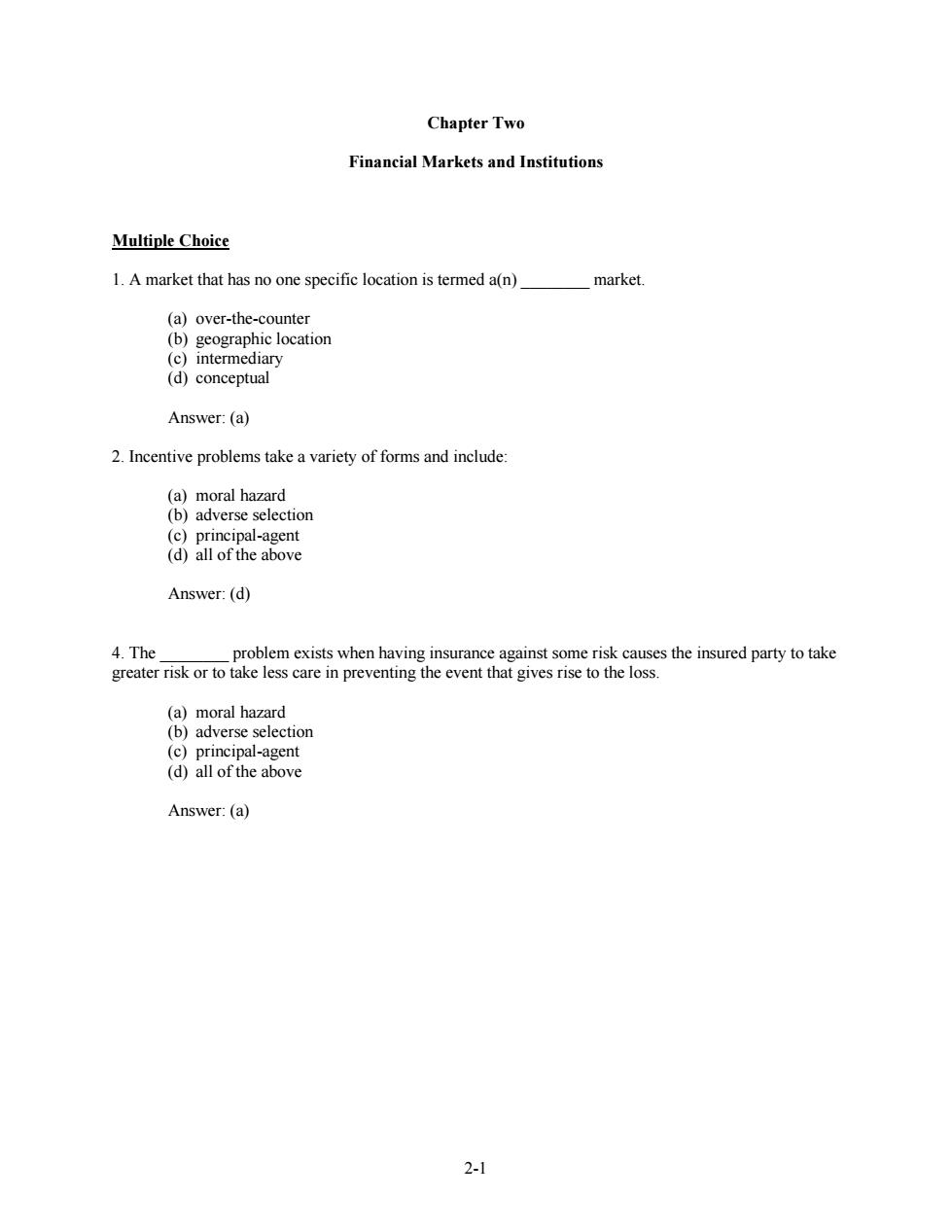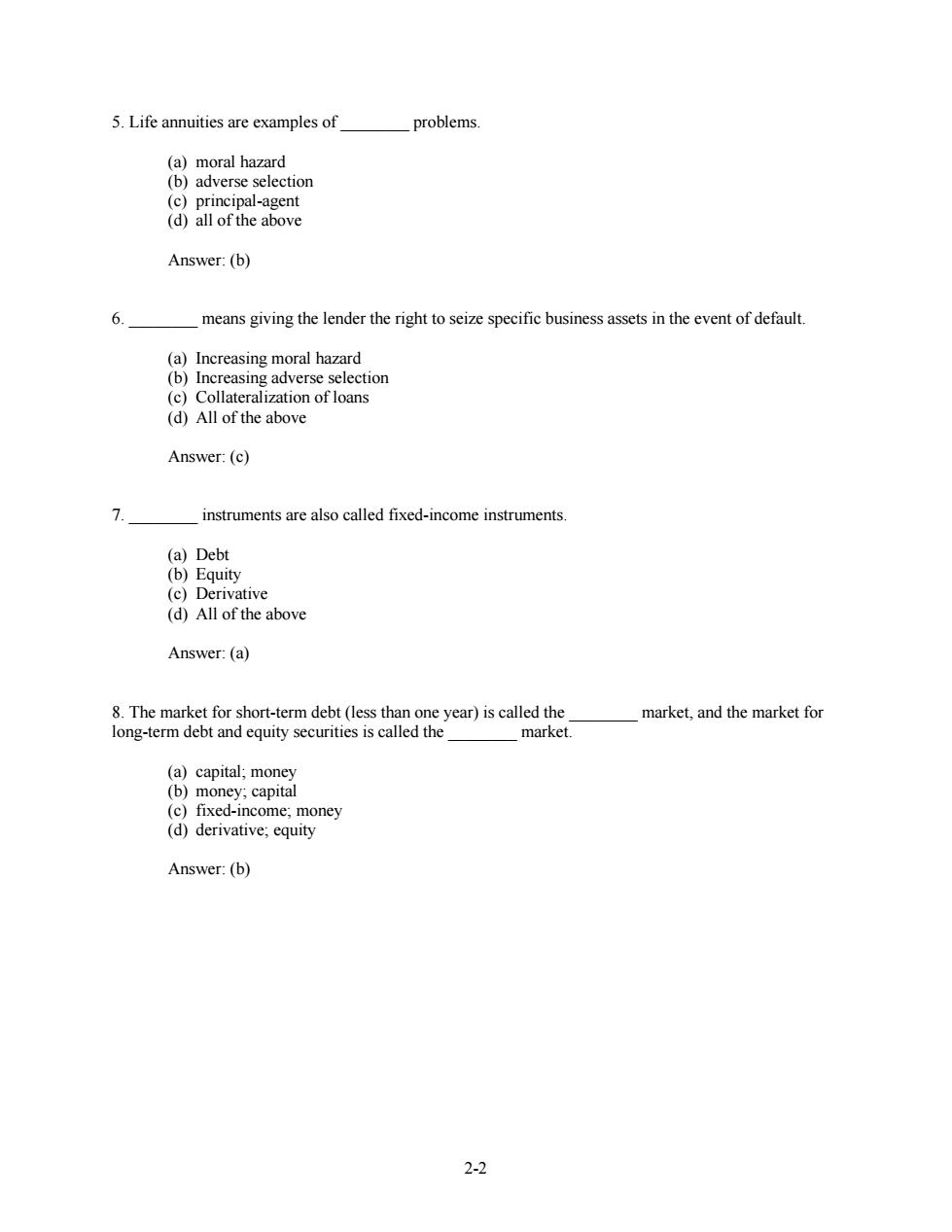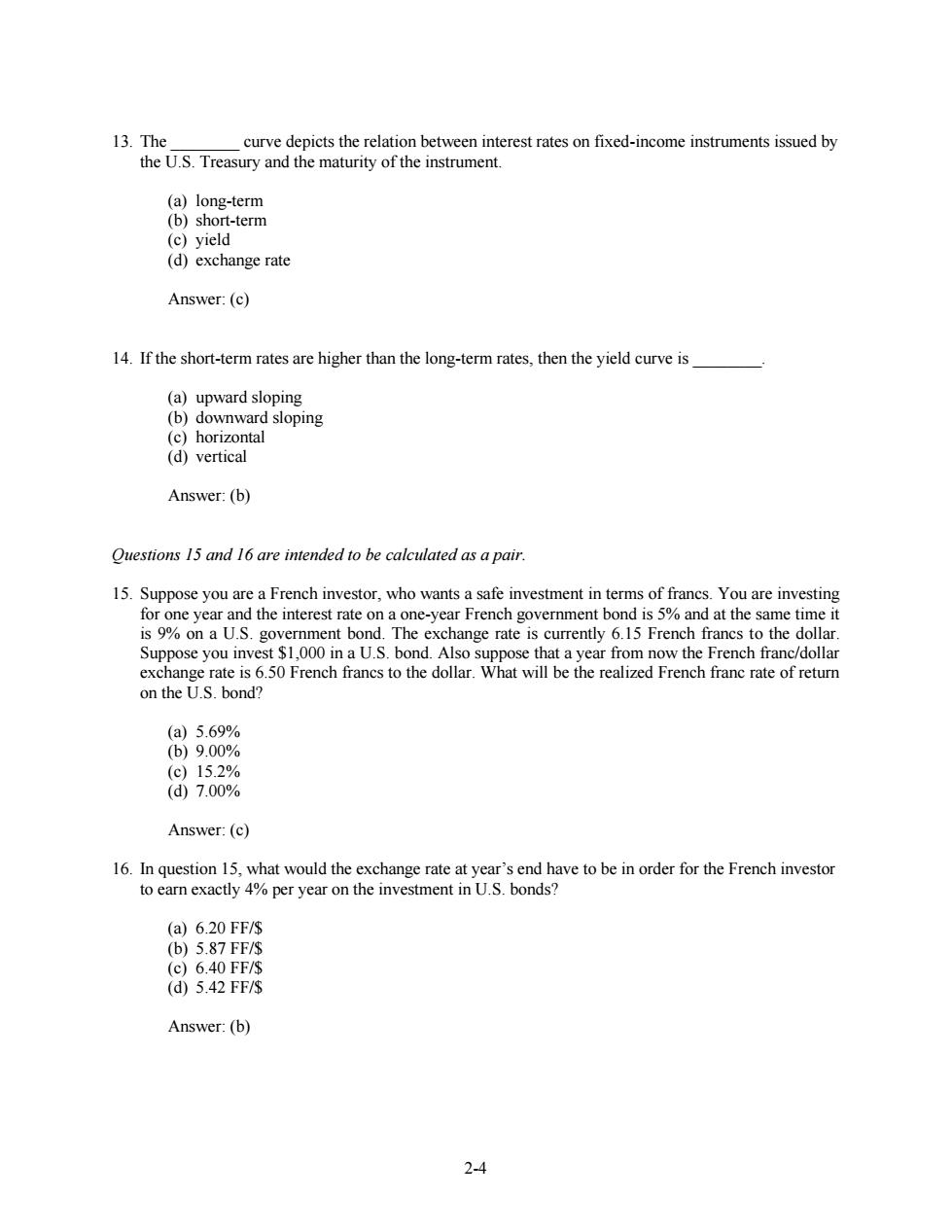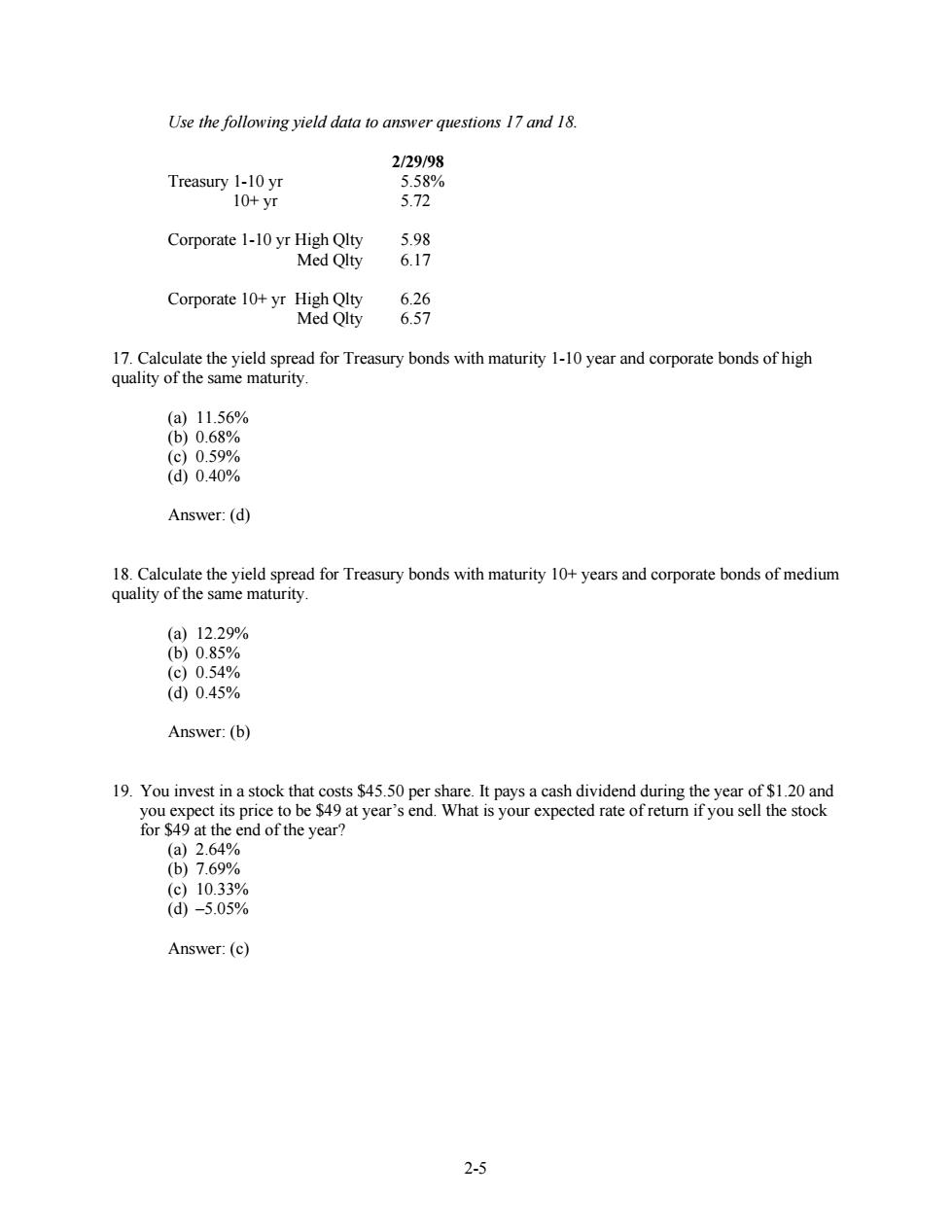
Chapter Two Financial Markets and Institutions Multiple Choice 1.A market that has no one specific location is termed a(n) market. (a)over-the-counter (b)geographic location (c)intermediary (d)conceptual Answer:(a) 2.Incentive problems take a variety of forms and include: (a)moral hazard (b)adverse selection (c)principal-agent (d)all of the above Answer:(d) 4.The problem exists when having insurance against some risk causes the insured party to take greater risk or to take less care in preventing the event that gives rise to the loss. (a)moral hazard (b)adverse selection (c)principal-agent (d)all of the above Answer:(a) 2-1
2-1 Chapter Two Financial Markets and Institutions Multiple Choice 1. A market that has no one specific location is termed a(n) ________ market. (a) over-the-counter (b) geographic location (c) intermediary (d) conceptual Answer: (a) 2. Incentive problems take a variety of forms and include: (a) moral hazard (b) adverse selection (c) principal-agent (d) all of the above Answer: (d) 4. The ________ problem exists when having insurance against some risk causes the insured party to take greater risk or to take less care in preventing the event that gives rise to the loss. (a) moral hazard (b) adverse selection (c) principal-agent (d) all of the above Answer: (a)

5.Life annuities are examples of problems. (a)moral hazard (b)adverse selection (c)principal-agent (d)all of the above Answer:(b) 6 means giving the lender the right to seize specific business assets in the event of default. (a)Increasing moral hazard (b)Increasing adverse selection (c)Collateralization of loans (d)All of the above Answer:(c) 7. instruments are also called fixed-income instruments. (a)Debt (b)Equity (c)Derivative (d)All of the above Answer:(a) 8.The market for short-term debt(less than one year)is called the market,and the market for long-term debt and equity securities is called the market. (a)capital;money (b)money;capital (c)fixed-income;money (d)derivative;equity Answer:(b) 2-2
2-2 5. Life annuities are examples of ________ problems. (a) moral hazard (b) adverse selection (c) principal-agent (d) all of the above Answer: (b) 6. ________ means giving the lender the right to seize specific business assets in the event of default. (a) Increasing moral hazard (b) Increasing adverse selection (c) Collateralization of loans (d) All of the above Answer: (c) 7. ________ instruments are also called fixed-income instruments. (a) Debt (b) Equity (c) Derivative (d) All of the above Answer: (a) 8. The market for short-term debt (less than one year) is called the ________ market, and the market for long-term debt and equity securities is called the ________ market. (a) capital; money (b) money; capital (c) fixed-income; money (d) derivative; equity Answer: (b)

9 securities are financial instruments that derive their value from the prices of one or more other assets (a)Debt (b)Equity (c)Derivative (d)Fixed-income Answer:(c) 10.A call option gives its holder the right to some asset at a specified price on or before some specified expiration date. (a)sell (b)buy (c)loan (d)borrow Answer:(b) 11.A put option gives its holder the right to some asset at a specified price on or before some specified expiration date. (a)sell (b)buy (c)loan (d)borrow Answer:(a) 12. contracts oblige one party to the contract to buy,and the other party to sell,some asset at a specified price on some specified date. (a)Options (b)Uncertainty (c)Money market (d)Forward Answer:(d) 2-3
2-3 9. ________ securities are financial instruments that derive their value from the prices of one or more other assets. (a) Debt (b) Equity (c) Derivative (d) Fixed-income Answer: (c) 10. A call option gives its holder the right to ________ some asset at a specified price on or before some specified expiration date. (a) sell (b) buy (c) loan (d) borrow Answer: (b) 11. A put option gives its holder the right to ________ some asset at a specified price on or before some specified expiration date. (a) sell (b) buy (c) loan (d) borrow Answer: (a) 12. ________ contracts oblige one party to the contract to buy, and the other party to sell, some asset at a specified price on some specified date. (a) Options (b) Uncertainty (c) Money market (d) Forward Answer: (d)

13.The curve depicts the relation between interest rates on fixed-income instruments issued by the U.S.Treasury and the maturity of the instrument. (a)long-term (b)short-term (c)yield (d)exchange rate Answer:(c) 14.If the short-term rates are higher than the long-term rates,then the yield curve is (a)upward sloping (b)downward sloping (c)horizontal (d)vertical Answer:(b) Questions 15 and 16 are intended to be calculated as a pair. 15.Suppose you are a French investor,who wants a safe investment in terms of francs.You are investing for one year and the interest rate on a one-year French government bond is 5%and at the same time it is 9%on a U.S.government bond.The exchange rate is currently 6.15 French francs to the dollar. Suppose you invest $1,000 in a U.S.bond.Also suppose that a year from now the French franc/dollar exchange rate is 6.50 French francs to the dollar.What will be the realized French franc rate of return on the U.S.bond? (a)5.69% (b)9.00% (c)15.2% (d7.00% Answer:(c) 16.In question 15,what would the exchange rate at year's end have to be in order for the French investor to earn exactly 4%per year on the investment in U.S.bonds? (a)6.20FF/$ (b)5.87FF/$ (c)6.40FF/$ (d)5.42FF/$ Answer:(b) 2-4
2-4 13. The ________ curve depicts the relation between interest rates on fixed-income instruments issued by the U.S. Treasury and the maturity of the instrument. (a) long-term (b) short-term (c) yield (d) exchange rate Answer: (c) 14. If the short-term rates are higher than the long-term rates, then the yield curve is ________. (a) upward sloping (b) downward sloping (c) horizontal (d) vertical Answer: (b) Questions 15 and 16 are intended to be calculated as a pair. 15. Suppose you are a French investor, who wants a safe investment in terms of francs. You are investing for one year and the interest rate on a one-year French government bond is 5% and at the same time it is 9% on a U.S. government bond. The exchange rate is currently 6.15 French francs to the dollar. Suppose you invest $1,000 in a U.S. bond. Also suppose that a year from now the French franc/dollar exchange rate is 6.50 French francs to the dollar. What will be the realized French franc rate of return on the U.S. bond? (a) 5.69% (b) 9.00% (c) 15.2% (d) 7.00% Answer: (c) 16. In question 15, what would the exchange rate at year’s end have to be in order for the French investor to earn exactly 4% per year on the investment in U.S. bonds? (a) 6.20 FF/$ (b) 5.87 FF/$ (c) 6.40 FF/$ (d) 5.42 FF/$ Answer: (b)

Use the following yield data to answer questions 17 and 18. 2/29/98 Treasury 1-10 yr 5.58% 10+yr 5.72 Corporate 1-10 yr High Qlty 5.98 Med Qlty 6.17 Corporate 10+yr High Qlty 6.26 Med Olty 6.57 17.Calculate the yield spread for Treasury bonds with maturity 1-10 year and corporate bonds of high quality of the same maturity. (a)11.56% (b)0.68% (c)0.59% (d0.40% Answer:(d) 18.Calculate the yield spread for Treasury bonds with maturity 10+years and corporate bonds of medium quality of the same maturity. (a)12.29% (b)0.85% (c)0.54% (d0.45% Answer:(b) 19.You invest in a stock that costs $45.50 per share.It pays a cash dividend during the year of $1.20 and you expect its price to be $49 at year's end.What is your expected rate of return if you sell the stock for $49 at the end of the year? (a)2.64% (b)7.69% (c)10.33% (d)-5.05% Answer:(c) 2-5
2-5 Use the following yield data to answer questions 17 and 18. 2/29/98 Treasury 1-10 yr 5.58% 10+ yr 5.72 Corporate 1-10 yr High Qlty 5.98 Med Qlty 6.17 Corporate 10+ yr High Qlty 6.26 Med Qlty 6.57 17. Calculate the yield spread for Treasury bonds with maturity 1-10 year and corporate bonds of high quality of the same maturity. (a) 11.56% (b) 0.68% (c) 0.59% (d) 0.40% Answer: (d) 18. Calculate the yield spread for Treasury bonds with maturity 10+ years and corporate bonds of medium quality of the same maturity. (a) 12.29% (b) 0.85% (c) 0.54% (d) 0.45% Answer: (b) 19. You invest in a stock that costs $45.50 per share. It pays a cash dividend during the year of $1.20 and you expect its price to be $49 at year’s end. What is your expected rate of return if you sell the stock for $49 at the end of the year? (a) 2.64% (b) 7.69% (c) 10.33% (d) –5.05% Answer: (c)